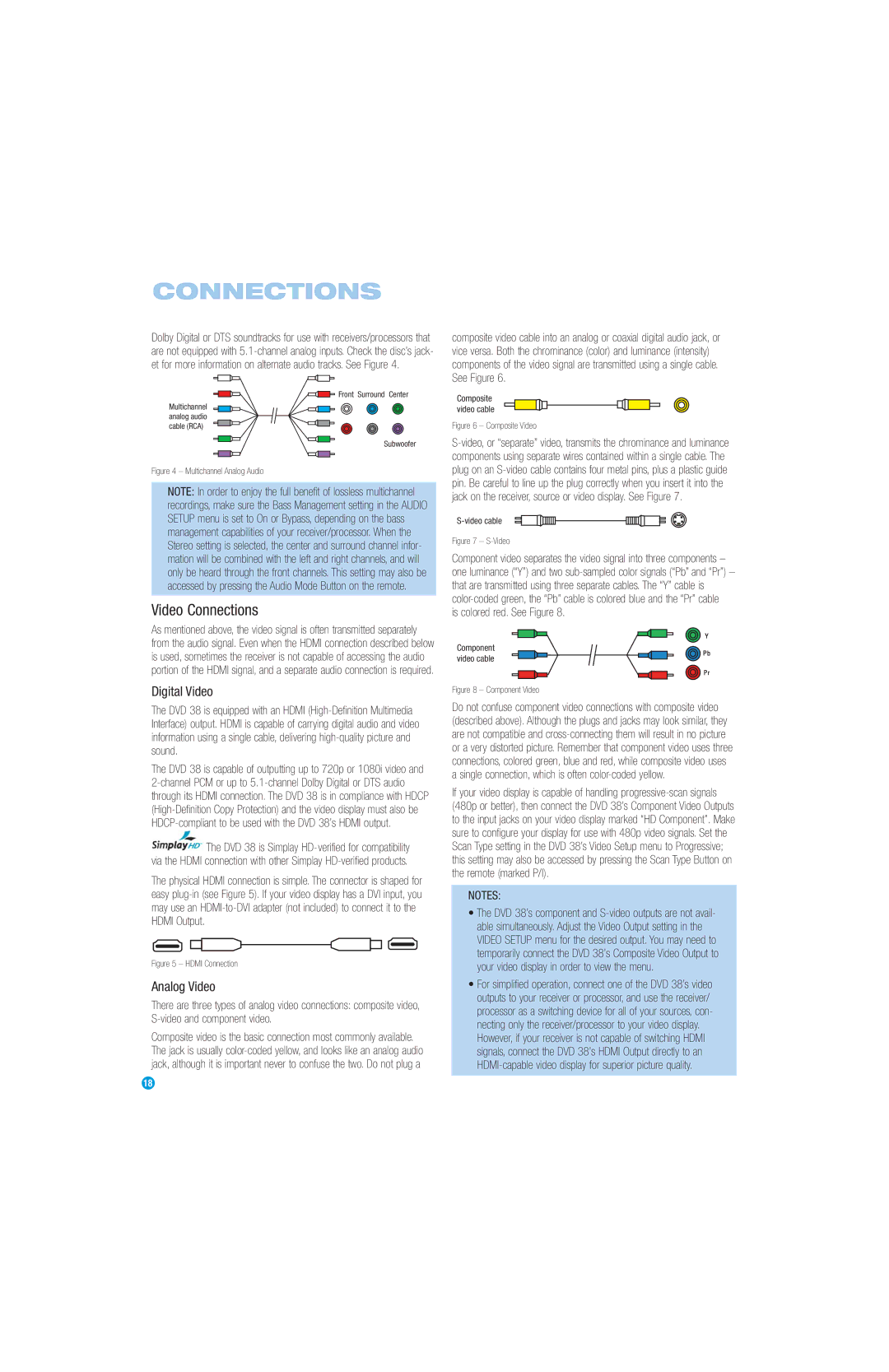
CONNECTIONS
Dolby Digital or DTS soundtracks for use with receivers/processors that are not equipped with
Front Surround Center
Multichannel analog audio cable (RCA)
Subwoofer
Figure 4 – Multichannel Analog Audio
NOTE: In order to enjoy the full benefit of lossless multichannel recordings, make sure the Bass Management setting in the AUDIO SETUP menu is set to On or Bypass, depending on the bass management capabilities of your receiver/processor. When the Stereo setting is selected, the center and surround channel infor- mation will be combined with the left and right channels, and will only be heard through the front channels. This setting may also be accessed by pressing the Audio Mode Button on the remote.
Video Connections
As mentioned above, the video signal is often transmitted separately from the audio signal. Even when the HDMI connection described below is used, sometimes the receiver is not capable of accessing the audio portion of the HDMI signal, and a separate audio connection is required.
Digital Video
The DVD 38 is equipped with an HDMI
The DVD 38 is capable of outputting up to 720p or 1080i video and
![]() The DVD 38 is Simplay
The DVD 38 is Simplay
The physical HDMI connection is simple. The connector is shaped for easy
Figure 5 – HDMI Connection
Analog Video
There are three types of analog video connections: composite video,
Composite video is the basic connection most commonly available. The jack is usually
composite video cable into an analog or coaxial digital audio jack, or vice versa. Both the chrominance (color) and luminance (intensity) components of the video signal are transmitted using a single cable. See Figure 6.
Composite video cable
Figure 6 – Composite Video
Figure 7 – S-Video
Component video separates the video signal into three components – one luminance (“Y”) and two sub-sampled color signals (“Pb” and “Pr”) – that are transmitted using three separate cables. The “Y” cable is color-coded green, the “Pb” cable is colored blue and the “Pr” cable
is colored red. See Figure 8.
Component video cable
Figure 8 – Component Video
Do not confuse component video connections with composite video (described above). Although the plugs and jacks may look similar, they are not compatible and cross-connecting them will result in no picture or a very distorted picture. Remember that component video uses three connections, colored green, blue and red, while composite video uses a single connection, which is often color-coded yellow.
If your video display is capable of handling progressive-scan signals (480p or better), then connect the DVD 38’s Component Video Outputs to the input jacks on your video display marked “HD Component”. Make sure to configure your display for use with 480p video signals. Set the Scan Type setting in the DVD 38’s Video Setup menu to Progressive; this setting may also be accessed by pressing the Scan Type Button on the remote (marked P/I).
NOTES:
•The DVD 38’s component and S-video outputs are not avail- able simultaneously. Adjust the Video Output setting in the VIDEO SETUP menu for the desired output. You may need to temporarily connect the DVD 38’s Composite Video Output to your video display in order to view the menu.
•For simplified operation, connect one of the DVD 38’s video outputs to your receiver or processor, and use the receiver/ processor as a switching device for all of your sources, con- necting only the receiver/processor to your video display.
However, if your receiver is not capable of switching HDMI signals, connect the DVD 38’s HDMI Output directly to an
18
